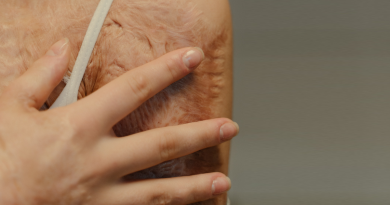Understanding melanoma with a surgical oncologist

May is Melanoma Awareness Month, dedicated to raising awareness about one of the deadliest forms of skin cancer. To shed light on this important topic, we sat down with Dr. E. Ramsay Camp, Baylor Medicine surgical oncologist, to answer some common questions about melanoma.
Question: What is melanoma, and why is it so dangerous?
Answer: Melanoma is a type of skin cancer that develops in the cells that produce melanin, the pigment that gives your skin its color. Its danger lies in its ability to metastasize, spreading rapidly to other organs and tissues if not caught and treated early. Though it is less common than some other types of skin cancer, it is more likely to grow and spread.
Q: What are the risk factors for developing melanoma?
A: Several factors can increase your risk of developing melanoma, including:
- UV exposure: prolonged exposure to ultraviolet (UV) radiation from sunlight or tanning beds is a significant risk factor.
- Fair skin: individuals with fair skin, light hair and light eyes are more susceptible.
- Family history: a family history of melanoma or other skin cancers can elevate your risk.
- Presence of moles: having many moles or atypical moles increases the likelihood of melanoma.
- Weakened immune system: immunocompromised individuals are at higher risk.
Q: How can people prevent melanoma?
A: Prevention is key, and there are several steps you can take to protect yourself:
- Use sunscreen: apply a broad-spectrum sunscreen with SPF 30 or higher whenever you’re outdoors.
- Seek shade: especially during peak sun hours between 10 a.m. and 4 p.m.
- Wear protective clothing: hats, sunglasses and clothing with UPF protection can shield your skin from harmful UV rays.
- Avoid tanning beds: they emit harmful UV radiation and increase your risk of skin cancer.
- Get regular full-body skin checks, especially those who are at greater risk.
Q: What are the warning signs of melanoma?
A: Remember the ABCDEs of melanoma:
- Asymmetry: one half of the mole doesn’t match the other half.
- Border irregularity: the edges are ragged, notched or blurred.
- Color: the color is uneven, with shades of brown, black, or even pink, red or white.
- Diameter: the mole is larger than 6 millimeters (about the size of a pencil eraser).
- Evolution: the mole changes in size, shape or color over time or starts to itch, bleed or crust.
Q: How is melanoma diagnosed and treated?
A: Diagnosis typically starts with a biopsy of suspicious lesions, which are then examined under a microscope for histopathological analysis. For localized melanoma, the mainstay of treatment is surgical excision, which aims to remove the tumor along with a margin of healthy tissue. In more advanced cases, surgical procedures may be complemented by additional treatments such as immunotherapy, targeted therapy or radiation therapy.
We hope that you won’t require our services, but in the event that you do, the Dan L Duncan Comprehensive Cancer Center provides specialized care for melanoma at every stage. Our team comprises experts from various disciplines who collaborate to tailor personalized treatment plans for each patient. Our objective is not only to deliver exceptional clinical care but also to conduct pioneering research in cancer detection, treatment and prevention.
– By Tiffany Harston, communications associate with the Michael E. DeBakey Department of Surgery



